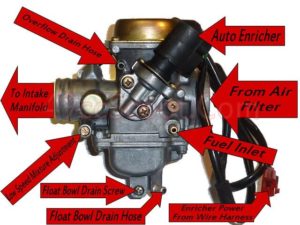AIR/FUEL MIXTURE ADJUSTMENT:
Adjusting the CVK carburetor found on most GY6 engines is pretty easy, but you have to have a couple things sorted out before you start or it’s a waste of time. The valves must be adjusted properly (.004” intake, .005” exhaust) and you must have a strong spark. If the valves are way out of adjustment or there is weak (or no) spark, no amount of carb tuning will make the engine run well. It should go without saying, but the fuel and vacuum hoses also need to be in good condition and hooked up the right way.
The basic idea of adjusting the CVK carb is to set the air/fuel mixture screw to provide the highest idle setting possible. Most CVK carbs have the air/fuel mixture screw on the intake manifold side of the carburetor (toward the engine, away from the air filter). Some stock carburetors come with a plug or a cap over the air/fuel mixture screw. You can carefully drill this plug out, or just replace the whole carb with something better for about $25.00.
Start your scooter and let it run for 10 minutes to get the engine up to operating temperature and allow the auto-choke (enricher) to close completely. If the carburetor is so far out of adjustment that the scooter won’t start, turn the air/fuel mixture screw all the way in until it stops, then turn it back out about 2 turns as a baseline setting. If it still won’t start after that, it’s time to clean or replace the carb.
While dialing in the air/fuel mixture, you will most likely have to adjust your idle speed down a bit. If the scoot tries to move on its own while you are tuning it, the idle is way too high. Set the idle around 1,000-1,400 RPM if you have a tachometer. If you can put a couple blocks under the engine to raise the rear wheel slightly off the ground, you can just adjust the idle speed until the engine is running smoothly, but the rear wheel doesn’t turn until you give it a little bit of throttle.
When you start adjusting the carb, the air fuel mix could be too rich, or too lean. Taking a look at your spark plug can give you a pretty good idea which it is, but it’s simple enough to just try adjusting in both directions that it’s probably not worth the time and effort.
1) TO MAKE THE AIR/FUEL MIXTURE RICHER:
Turn the Air/Fuel Mixture COUNTER CLOCKWISE 1/4 turn and wait about 30 seconds to allow the engine to respond to the new setting.
a. If the RPM’s go up, repeat step 1 in ¼ turn increments until the RPM’s begin to drop.
b. Once you find the setting where the RPM’s begin to drop, turn the Air/Fuel mixture screw about 1/8 turn CLOCKWISE and that should be close to the ideal Air/Fuel mixture setting.
If the engine RPM’s drop on the FIRST 1/4 turn from the starting point, turn the screw back to the starting position and wait 30 seconds until the engine responds, then go to #2
2) TO MAKE THE AIR/FUEL MIXTURE LEANER:
Turn the Air/Fuel Mixture CLOCKWISE 1/4 turn and wait about 30 seconds to allow the engine to respond to the new setting.
a. If the RPM’s go up, repeat step 1 in ¼ turn increments until the RPM’s begin to drop.
b. Once you find the setting where the RPM’s begin to drop, turn the Air/Fuel mixture screw about 1/8 turn COUNTER CLOCKWISE and that should be close to the ideal Air/Fuel Mixture setting.
3) IDLE SPEED ADJUSTMENT:
After dialing in the air/fuel mixture, turn the idle speed screw until the engine runs smooth and doesn’t try to take off on its own.
4) NOTHING HAPPENED?
If the engine RPM’s don’t change at all after trying to adjust the mixture in both directions, you most likely have a badly clogged pilot jet. Assuming the engine was completely warmed up and the auto-choke circuit is working properly, it’s time to remove the carb and give it a thorough cleaning or replace it with a new one.



.jpg)



